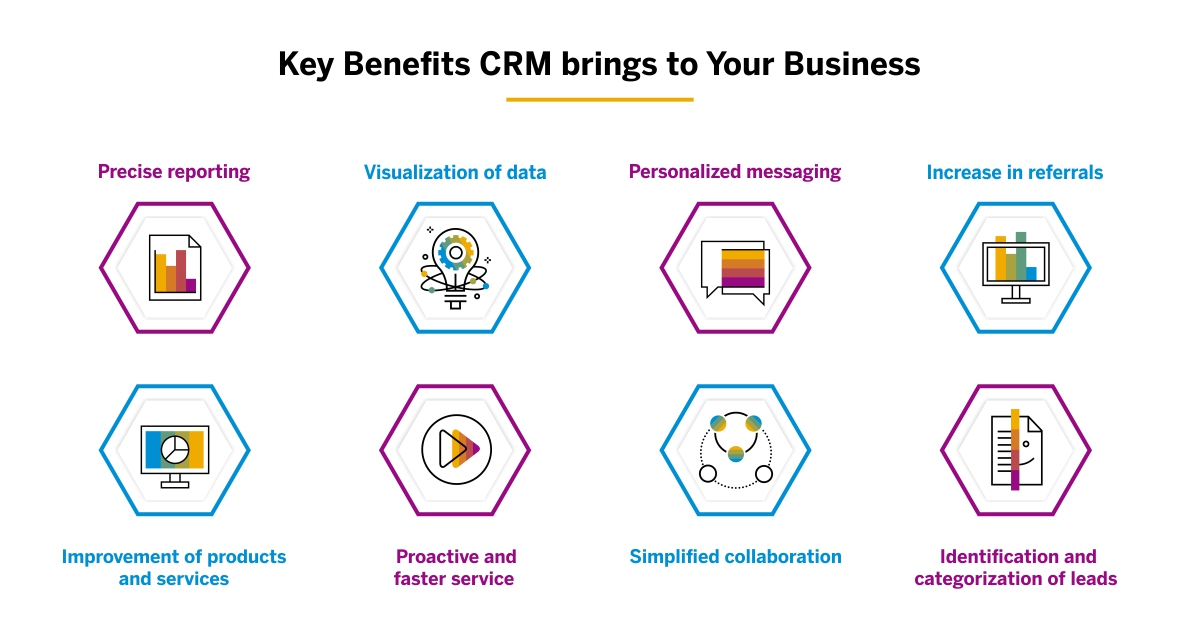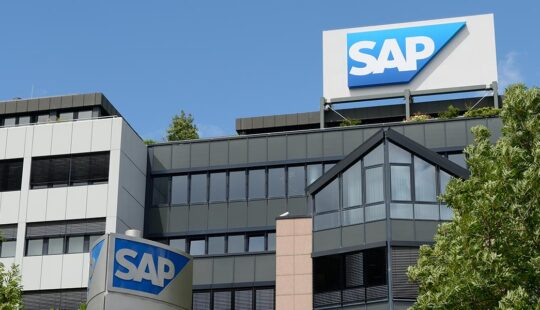To win in today’s omnichannel world, businesses need to know exactly where their customer interactions take place, how they fare in these interactions, and identify areas where service levels can be improved. Again, for any business to thrive in the highly digital world we are in, there’s a need to have one consolidated dashboard view of customers or potential customers to figure out ways and means to sell more, faster. In both instances, Customer Relationship Management (CRM) software can make all the difference.
These and myriad other reasons are making CRMs a must-have in any growing business’s IT infrastructure. It also explains why there has been a significant demand for adopting CRM offerings and solutions via the Software as a Service (SaaS) model. According to reports, the global CRM market size is expected to reach $94.4 billion by 2027, rising with a market growth of 11.3% CAGR during the forecast period.

Simply put, CRM can help you leverage data to build long-lasting customer relationships, which can help drive sales and profits. But how can a software become pivotal to any business’ customer-centricity? Because, at the heart of it, the CRM tool creates a simple interface that brings all of your customer data across all your key business operations (marketing, sales and pre-sales) onto a single platform. But let’s explore CRM further.
Customer Relationship Management – the essence
In its essence, CRM will help you answer these questions that becomes a hurdle to sales teams when they are figuring out the pipeline or when marketing teams are identifying a target audience for their go-to-market strategy or new product launch campaign:
- Who are our customers?
- What are they buying and have they been a repeat buyer?
- How do we approach them?
- What’s the best way to approach them?
CRM is a service-based technology that forms a link between a company and its existing and potential customers and manages relationships and interactions between them. For instance, it tracks the history of a customer with the business, which includes any outstanding customer service issues and the status of pending orders. The CRM software uses data analysis to process large amounts of information, thereby helping to streamline business processes and profitability and improve business relationships between a company and its customers.
The information used by CRM software is obtained from various sources like websites, social media channels, and contact details such as phone number and email ID. The data received through these sources helps a business understand its existing and potential customers and their needs and expectations. Leveraging CRM also helps a business work on customer retention and attract new customers, which are vital for any business in the modern competitive world.
Benefits of Customer Relationship Management (CRM)
While it depends on the type of industry, size of business, and various other factors, CRM can bring a host of benefits to the table almost every time. Here are some of them:
• Precise reporting – For the proper functioning of a business, especially a service-oriented businesses, direct interaction with the targeted audience is the first and foremost step that needs to be established, and this is where CRM software plays a major role. It helps in enhanced sorting and analysis of customer data with the help of its advanced reporting abilities. A CRM software also helps in identifying prospective customers, who are trying to reach out to the business. For example, if a customer fills a form on a company website after seeing an ad on the internet, it signals that they are interested in the product/service.
• Visualization of data – CRM software helps in better arrangement and recording of data, which can be an exhausting and time-consuming process if done manually. A CRM software can sort and arrange data into spreadsheets, analyze which piece of information is crucial and even represent it graphically. This saves a lot of time and effort and also arranges and presents the data in an easy-to-understand manner.
• Personalized messaging – CRM tools have made the lives of sales and marketing personnel easier by creating relevant and personalized messaging for the targeted audience. With the help of dynamic and automated processes and unique campaigns, they can can identify potential leads and reselling opportunities.
• Increase in referrals – Since CRM software helps in understanding the needs and requirements of existing customers in a better manner, these customers have a positive perception about the company. This can lead to positive feedback and generation of new leads in the form of referrals.
• Improvement of products and services – Based on the feedback received by CRM software from the existing customers, a company can work towards improving the product or service. It can be done by identifying common pain points and resolving the shortcomings in them.
• Proactive and faster service – CRM software enables companies to provide services and solutions to their customers at a much faster rate. With the help of relevant data, the sales and service teams can identify potential needs or pain points, connect with the customer proactively, and offer support or new products. Such faster service will enhance customer satisfaction, which is helpful in both customer retention and attraction.
• Simplified collaboration – A good CRM software should be capable of recording both internal and external conversations between a company representative and a customer. Using these collaboration tools leads to synergy between different teams within the company, and ultimately allows the progress of a process or plan.
• Identification and categorization of leads – CRM software can categorize leads more accurately by arranging them properly after identifying them. It helps in focusing more on quality leads, which eventually helps in improving the conversion rate. It can also identify the leads that require more nurturing by marketing teams.

Impact of CRM on a business
CRM can optimally help growing businesses and medium-sized enterprises become more profitable by helping them define their sales targets, business objectives, and profitability projections – the three main pillars that help an organization survive disruptions and thrive beyond it. CRM provides a clear view of what the target audience thinks and expects.
Apart from the sales and marketing departments, even customer service teams can leverage CRM systems to resolve the problems and issues raised by a customer. Using CRM software, a company can manage an inquiry across omnichannels, including social platforms.
The lack of a CRM system can lead to missed opportunities – especially the inability to leverage data and derive insights from data – along with the likelihood of improper data management, inconsistency in data collection, and irregularity in data prioritization. Insufficient data or the lack of it could result in inefficiencies in customer relationship management, reduced customer loyalty, and consequently, loss of business and goodwill.
Basic process flow of a CRM software
The main focus of CRM software is to gather and organize data from the customer, identify trends and patterns in the data thus collected, and enable the business to build on these insights.
The first step in the CRM journey is, therefore, collecting data. The CRM software collects:
- Data of existing customers – These include contact details, the customer’s purchase history, records of their previous interactions with the company, observations of personnel who have interacted with the customer, and any other relevant information. Even the activity on social media platforms, such as likes and dislikes, comments, and shares about a business and its competitors, will be included here. It tracks and logs in customer history, which could include complaints, customer service issues, etc.
- Digital data collection – Data can also be assimilated from new leads got through webforms, email queries, email marketing efforts, and outbound calls.
- Based on all the data collected, the CRM software creates a unique customer ID/persona that gives a 360-degree view of the customer, their likes and dislikes, various points of interactions, orders placed, etc. Such automatically generated insights let the business understand its customers better and predict their future behavior and potential needs better. Customers are segregated into groups for targeted outreach and personalized marketing efforts.
- The business can reach out to the customers, make them more aware of the product/brand, and drive engagement. CRM tools help in lead enrichment and driving conversations with the audience here. With the help of CRM lead scoring tools, sales reps can identify how interested these leads are and nurture them to make a purchase.
- Superior customer service and support is the next step, and a very important one at that. Your agents will have the customer information and tools they need to fix a client’s issues quickly and easily. CRM tools will not only enable them to provide omnichannel support, but also to manage those conversations in a single, unified window.
- CRM software also helps reps find upsell opportunities with existing customers, after which, the cycle repeats itself.
Components of a CRM
New generation CRM software tools are proficient in automating administrative tasks such as data entry and lead generation with the help of built-in intelligence. There are various components of a CRM software that can be used to ensure the success of an organization. These are:
- Salesforce Automation
One of the most essential and widely used components of CRM, salesforce automation is responsible for various processes such as forecasting and recording sales processes and tracking of interactions with potential customers. This component helps in understanding the revenue generation chances by analyzing sales forecasts and performances of workforces. For carrying out all these tasks, salesforce automation employs various tools like lead management, opportunity management, forecasting, contact management, email management, and reporting.
- Human Resource Management
Human resource management (HRM) allows manual, repetitive tasks to be automated freeing up time of skilled HR professionals in doing what they do best – manage talent and be strategic in today’s hybrid working model. CRMs can actually be one of the most important investment that companies can make to ensure efficiency in HRM. From recruitment to lead scoring of candidates, CRM can be modified to help the HR function become more strategic in their approach to all human resource planning and management. Especially useful to both large-scale and medium-scale companies, HRM carries out a strategy for studying skills and selecting the most suitable workforce for implementing a specific task.
- Lead Management
Usually, lead management is used by sales and marketing teams as well as customer executive centers. The processes involved in lead management include designing customized forms, finalizing the lists of customers, and management of campaigns. Based on the purchase pattern of both existing and potential customers, lead management helps in converting the maximum number of leads into sales.
- Customer Service
Customer service involves a joint effort of all departments, including sales and marketing. Based on feedback and individual customer complaints, the CRM tool for customer service provides optimal solutions to resolve issues, identify pain points, and increase the customer’s trust in the company.
- Marketing
This component of the CRM software revolves around the promotional efforts required for making the product reach maximum customers. The CRM tool helps the marketing department in crafting and implementing strategies, as well as their consistent improvement. The tools that are used here include list management, activity management, campaign management, call management, and document management. The use of these tools depends on factors such as the type of the business and requirements, as well as the size of the targeted audience.
- Workflow Automation
This helps in streamlining the processes carried out in a company, leading to cost optimization, eliminating repetitive tasks, and making the workflow more economical and efficient. It also makes the workforce more efficient by reducing the time and effort needed for carrying out a job.
- Business Reporting
These reports enable leaders to get an insight into the working of various departments of the company. Apart from efficient work management of teams, it can also help in monitoring the progress of the company as a whole. At the departmental level, business reports help forecast demand, compare efficiencies of various departments, and save costs.
- Analytics
One of the most touted uses of CRM, this component helps the study and representation of data in a way that allows every user to gather meaningful insights. The data is visually presented via charts, histograms, and diagrams, which makes it easier for users to understand the data, and also gives clear comparisons. Users can analyze performances and track records as well as study shifts in trends with time. The ability to identify changing trends is significant to a company’s growth and well-being, and CRM software can help organizations track trends effectively.
To truly get the most out of CRM, you need to know which CRM software is best for your company. The answer is contingent on the nature of your business. If you run a small business, an agency, or a startup, for example, you should start with a free plan. You can switch to a subscription plan as your company expands, which includes advanced automation tools that can make work easier for hundreds of employees. You’ll need an integrated system with marketing, sales, and customer support tools to truly satisfy your customers.
Whatever you decide to select, there is no getting around the fact that CRM software is a must to enhance customer service levels and grow your business in today’s customer-first world!



